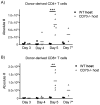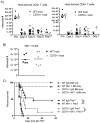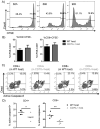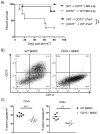Host-Derived CD70 Suppresses Murine Graft-versus-Host Disease by Limiting Donor T Cell Expansion and Effector Function
- PMID: 28550198
- PMCID: PMC5503479
- DOI: 10.4049/jimmunol.1502181
Host-Derived CD70 Suppresses Murine Graft-versus-Host Disease by Limiting Donor T Cell Expansion and Effector Function
Abstract
Allogeneic hematopoietic cell transplantation (allo-HCT) is a potentially curative treatment for hematologic and immunologic diseases. However, graft-versus-host disease (GVHD) may develop when donor-derived T cells recognize and damage genetically distinct normal host tissues. In addition to TCR signaling, costimulatory pathways are involved in T cell activation. CD27 is a TNFR family member expressed on T cells, and its ligand, CD70, is expressed on APCs. The CD27/CD70 costimulatory pathway was shown to be critical for T cell function and survival in viral infection models. However, the role of this pathway in allo-HCT is previously unknown. In this study, we have examined its contribution in GVHD pathogenesis. Surprisingly, Ab blockade of CD70 after allo-HCT significantly increases GVHD. Interestingly, whereas donor T cell- or bone marrow-derived CD70 plays no role in GVHD, host-derived CD70 inhibits GVHD as CD70-/- hosts show significantly increased GVHD. This is evidenced by reduced survival, more severe weight loss, and increased histopathologic damage compared with wild-type hosts. In addition, CD70-/- hosts have higher levels of proinflammatory cytokines TNF-α, IFN-γ, IL-2, and IL-17. Moreover, accumulation of donor CD4+ and CD8+ effector T cells is increased in CD70-/- versus wild-type hosts. Mechanistic analyses suggest that CD70 expressed by host hematopoietic cells is involved in the control of alloreactive T cell apoptosis and expansion. Together, our findings demonstrate that host CD70 serves as a unique negative regulator of allogeneic T cell response by contributing to donor T cell apoptosis and inhibiting expansion of donor effector T cells.
Copyright © 2017 by The American Association of Immunologists, Inc.
Conflict of interest statement
Figures









Similar articles
-
The Role of Co-stimulatory/Co-inhibitory Signals in Graft-vs.-Host Disease.Front Immunol. 2018 Dec 21;9:3003. doi: 10.3389/fimmu.2018.03003. eCollection 2018. Front Immunol. 2018. PMID: 30627129 Free PMC article. Review.
-
T Cell-Derived CD70 Delivers an Immune Checkpoint Function in Inflammatory T Cell Responses.J Immunol. 2017 Nov 15;199(10):3700-3710. doi: 10.4049/jimmunol.1700380. Epub 2017 Oct 18. J Immunol. 2017. PMID: 29046346 Free PMC article.
-
An essential role for IFN-gamma in regulation of alloreactive CD8 T cells following allogeneic hematopoietic cell transplantation.Biol Blood Marrow Transplant. 2007 Jan;13(1):46-55. doi: 10.1016/j.bbmt.2006.09.014. Biol Blood Marrow Transplant. 2007. PMID: 17222752 Free PMC article.
-
Alloreactivity as therapeutic principle in the treatment of hematologic malignancies. Studies of clinical and immunologic aspects of allogeneic hematopoietic cell transplantation with nonmyeloablative conditioning.Dan Med Bull. 2007 May;54(2):112-39. Dan Med Bull. 2007. PMID: 17521527 Review.
-
Unexpected role of TNF-alpha in graft versus host reaction (GVHR): donor-derived TNF-alpha suppresses GVHR via inhibition of IFN-gamma-dependent donor type-1 immunity.Int Immunol. 2004 Jun;16(6):811-7. doi: 10.1093/intimm/dxh082. Epub 2004 May 4. Int Immunol. 2004. PMID: 15126416
Cited by
-
Targeting the CD27-CD70 Pathway to Improve Outcomes in Both Checkpoint Immunotherapy and Allogeneic Hematopoietic Cell Transplantation.Front Immunol. 2021 Sep 22;12:715909. doi: 10.3389/fimmu.2021.715909. eCollection 2021. Front Immunol. 2021. PMID: 34630390 Free PMC article. Review.
-
The Role of Co-stimulatory/Co-inhibitory Signals in Graft-vs.-Host Disease.Front Immunol. 2018 Dec 21;9:3003. doi: 10.3389/fimmu.2018.03003. eCollection 2018. Front Immunol. 2018. PMID: 30627129 Free PMC article. Review.
-
CD27 signaling inhibits tumor growth and metastasis via CD8 + T cell-independent mechanisms in the B16-F10 melanoma model.Cancer Immunol Immunother. 2024 Aug 6;73(10):198. doi: 10.1007/s00262-024-03780-9. Cancer Immunol Immunother. 2024. PMID: 39105866 Free PMC article.
-
Host-Derived Serine Protease Inhibitor 6 Provides Granzyme B-Independent Protection of Intestinal Epithelial Cells in Murine Graft-versus-Host Disease.Biol Blood Marrow Transplant. 2018 Dec;24(12):2397-2408. doi: 10.1016/j.bbmt.2018.07.003. Epub 2018 Jul 10. Biol Blood Marrow Transplant. 2018. PMID: 30006303 Free PMC article.
-
Co-stimulatory and co-inhibitory pathways in cancer immunotherapy.Adv Cancer Res. 2019;143:145-194. doi: 10.1016/bs.acr.2019.03.003. Epub 2019 Apr 17. Adv Cancer Res. 2019. PMID: 31202358 Free PMC article. Review.
References
-
- Gandy KL, Domen J, Aguila H, Weissman IL. CD8+TCR+ and CD8+TCR- cells in whole bone marrow facilitate the engraftment of hematopoietic stem cells across allogeneic barriers. Immunity. 1999;11:579–590. - PubMed
-
- Lee SJ, Klein JP, Barrett AJ, Ringden O, Antin JH, Cahn JY, Carabasi MH, Gale RP, Giralt S, Hale GA, Ilhan O, McCarthy PL, Socie G, Verdonck LF, Weisdorf DJ, Horowitz MM. Severity of chronic graft-versus-host disease: association with treatment-related mortality and relapse. Blood. 2002;100:406–414. - PubMed
-
- Chakrabarti S, Mautner V, Osman H, Collingham KE, Fegan CD, Klapper PE, Moss PA, Milligan DW. Adenovirus infections following allogeneic stem cell transplantation: incidence and outcome in relation to graft manipulation, immunosuppression, and immune recovery. Blood. 2002;100:1619–1627. - PubMed
-
- Reusser P, Riddell SR, Meyers JD, Greenberg PD. Cytotoxic T-lymphocyte response to cytomegalovirus after human allogeneic bone marrow transplantation: pattern of recovery and correlation with cytomegalovirus infection and disease. Blood. 1991;78:1373–1380. - PubMed
Publication types
MeSH terms
Substances
Grants and funding
LinkOut - more resources
Full Text Sources
Other Literature Sources
Molecular Biology Databases
Research Materials
Miscellaneous

